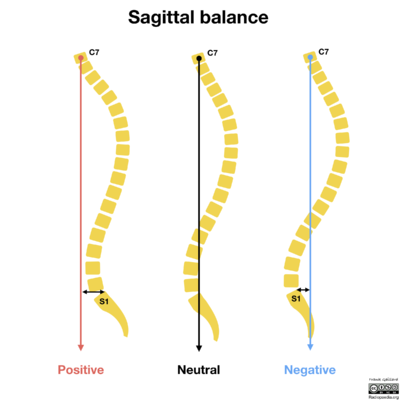Sagittal Balance of the Spine
Sagittal balance forms part of the plain radiographic assessment of spinal deformity including kyphotic or lordotic deformities and scoliosis.
Usage
There are numerous ways of assessing this, using various bony landmarks and angles to evaluate whether or not a normal distribution of weight and stresses is present through the axial skeleton, some incorporating the position of the head, while others focussing on the pelvis, have been described 1,2:
- C7 plumb line
- sagittal vertical axis
- chin-brow vertical angle
- kyphosis tilt angle
- pelvic incidence
- pelvic tilt
- sacral slope
- spinopelvic angle
- spinosacral angle
Whilst many methods exist to assess sagittal balance, an abnormal plumb line (in either direction) is predictive of higher rates of micromotion and dysfunction after solid fixation ref as well as adjacent level disease 4.
Measurement
C7 plumb line
One of the simplest and most widely used methods is performed on lateral standing full-length films and requires a vertical line (plumb line) drawn from the middle of the body of the C7 vertebral body. This line should pass through the superior endplate of S1, or more precisely within 2 cm (some use 1.7 cm) of the posterosuperior corner of the S1 vertebral body 1,2.
The position of this line is can be positive, neutral or negative:
- positive balance: the plumb line passes more than 2 cm in front of the posterosuperior corner of the S1 vertebral body
- neutral balance: the plumb line passes within 2 cm of the posterosuperior corner of the S1 vertebral body
- negative balance: the plumb line passes more than 2 cm behind the posterosuperior corner of the S1 vertebral body
See Also
- See Huec et al for a free open access article on this topic, from an orthopaedic surgery perspective. [1]
- Coronal Balance of the Spine
References
Part or all of this article or section is derived from Sagittal balance by Dr Henry Knipe and Assoc Prof Frank Gaillard et al., used under CC BY-NC-SA 3.0
Literature Review
- Reviews from the last 7 years: review articles, free review articles, systematic reviews, meta-analyses, NCBI Bookshelf
- Articles from all years: PubMed search, Google Scholar search.
- TRIP Database: clinical publications about evidence-based medicine.
- Other Wikis: Radiopaedia, Wikipedia Search, Wikipedia I Feel Lucky, Orthobullets,



